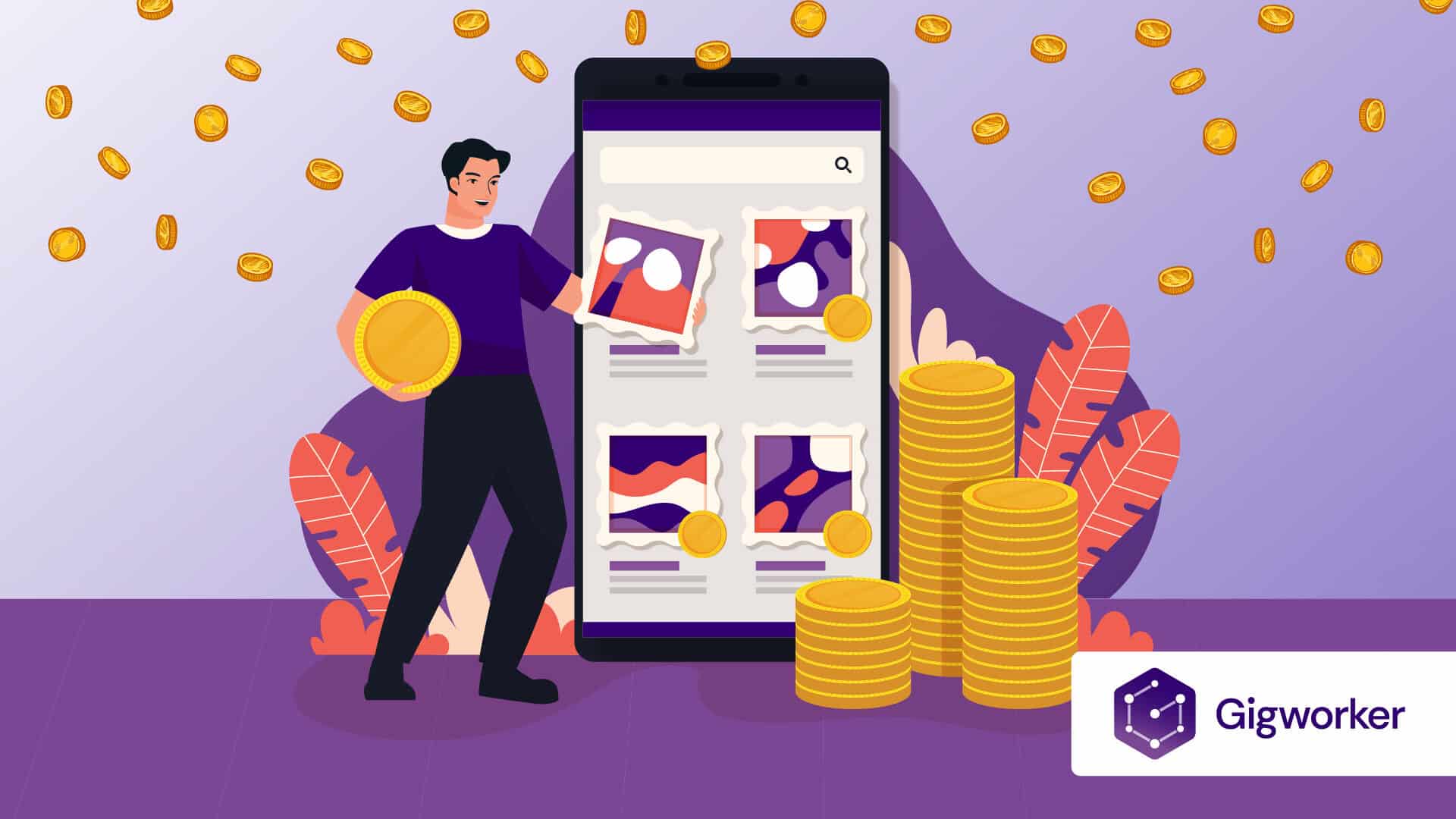Selling your art is tough, right?
By the end of this little read, you will understand the most essential angles in selling your digital.
Many digital artists, both newcomers and veterans, struggle to understand how to sell digital art, especially in this saturated art market.
Not only do they struggle to find the right audience, but they also don’t know how to set a proper price for their art.
No worries, though.
In this guide, you will find easy and rewarding ways to present, value, sell, and gain recognition as an artist.
Why You Should Consider Selling Digital Art
The creative market has been oversaturated for years and has been fueled even more during this post-COVID era of digital art.
However, there will always be new ways and creative platforms on which you will find larger audiences for your digital art.
It’s encouraging to think that selling digital art in today’s market is:
- Profitable: Most art buyers go online in this digital day and age. In 2021, online art sales skyrocketed by more than $16 billion compared to 2020 sales, which reached almost $8 billion.
- Lucrative: Some digital art sellers aren’t even full-time and still manage to snag a hefty profit from their artworks as passive income.
- Accessible: What’s interesting about digital art is that you can sell your work in multiple formats like original digital files, digital prints, physical products, printable artwork, branded merchandise, or otherwise.
- Flexible: Besides Etsy, Artsy, or creating your own NFTs as digital products, many business platforms offer significant percentages, which can greatly benefit the artist.
Problems With Selling Digital Art
Although selling digital art is easy and profitable, it can be tough and time-consuming, sometimes costing you more than you’ll profit.
There are many challenges digital artists face when trying to set up their own businesses. The most prevalent issues are:
- Finding your audience: This is the most prevalent reason why artists struggle to find a buyer for their artwork. Making a prominent name for yourself is definitely the most challenging step, especially for upcoming artists.
- Marketing: Artists aren’t businessmen, and vice versa. Many skilled painters with outstanding portfolios can’t seem to properly value and advertise their work.
- Fees: Digital art marketplaces can sometimes carry heavy fees that would burden artists’ momentum in creating a business for themselves.
- Competition: Art platforms like DivineArt and digital marketplaces like Etsy are popular, but they’re also highly competitive grounds full of artists with similar art styles. They can easily discourage rookie artists from searching for their audience.
- Piracy and scammers: Many artists have issues with blatant art theft. Despite proper licensing and watermarks, most of them have no guaranteed safety procedures from people stealing their intellectual property.
- Physical art triumphs over digital: People want to see ‘real art’, no matter how brilliant your pixelated artwork is. Potential buyers have a higher chance of purchasing a piece when they see it with their own eyes—preferably during an exhibition.
What You’ll Need to Sell Digital Art
Whether you’re selling original paintings, digital art prints, 3D objects, or NFT art, there are some essential steps and preparations to take.
Before you even think of setting up your art prices, you must complete the essential steps as a digital art seller.
Having a robust structure in your business is important, and you should consider the following steps:
- Digitize your artwork: Although it’s an obvious requirement, you must have a protected and backed-up digital version of your artwork. If you’re thinking of going digital, having original versions, either Adobe Illustrator or Corel Draw formats of your digital pieces, is a must.
- Create a website for your art: Having your own website means branding your work. You can find many hosting options and website construction tools to create and maintain your platform. Otherwise, showcasing your art pieces on Instagram or DeviantArt works, too, if you’re low on finances.
- Pick your marketing platform: If promoting your website doesn’t get you the right audiences, marketing platforms like Etsy or eBay work best. Analyze all your options to pick an eCommerce site suitable for your art style. Photographers, for example, never seem to run out of marketplace platforms.
- Pick your payment platforms: Once you have your platform or website ready, you still need to have your bank account linked to payment services like PayPal, Wise, or Skrill. Payoneer works best if PayPal isn’t available in your country.
- Paperwork and creative licenses: This may depend entirely on your business model, but if you’re willing to brand and protect your digital artwork, you need to register your business via creative commons and suitable licenses. Most artists just watermark their artwork to protect it, but you can take the step forward and license your work.
Where to Sell Digital Art
Most artists struggle with choosing the right place to find potential buyers for their digital products.
Don’t fret. Many websites serve as excellent digital art market platforms, and it’s up to you to find a suitable one.
Remember that having your artwork on multiple art marketplaces is always a good idea.
Here are some of the most popular ones:
1. Etsy

Since 2005, Etsy has been the go-to place for many artists seeking an online marketplace to sell their art.
You can find handmade art experts, crochet artists, photographers, and many other artists competing on this popular eCommerce platform to show off their pieces.
What Makes This Website Special
Sure, it’s a popular site, and it can be challenging for newcomers to fit in.
But what makes it so unique is that it offers opportunities for exposure, and you can easily build your reputation as a digital artist.
- Fees/Commission: Etsy charges a 20-cent listing fee when you put up a piece for sale, and if you complete a sale, they receive a 6.5% transaction fee.
- Payment Methods: Credit/debit/bank card, PayPal, Etsy gift cards and credits, Apple Pay, Google Pay, and Klarna Financing.
2. Saatchi Art

Saatchi Art acts more as an online gallery than an art marketplace, but it offers excellent exposure, especially for upcoming artists.
What Makes This Website Special
What’s so great about this platform is that the website has a community of experienced art enthusiasts who are not hesitant to support any artist.
Each week, there are special collections that are curated by their staff, and they help boost the sellers’ work.
- Fees/Commission: Because Saatchi Art offers free courier shipping options, they usually take a %35 commission fee for each of your sales. While it’s high for some, this commission fee is lower than most physical art galleries.
- Payment Methods: PayPal, check, or wire transfer.
3. Shopify

Although Shopify is a general marketplace platform, it’s an excellent start for artists looking for alternative artist shops.
What Makes This Website Special
Shopify has a very straightforward structure for artists who want to sell their pieces.
What’s more, it has website templates that allow you to customize your website, as well as marketing tools that can boost your sales.
- Fees/Commission: For every sale you make, Shopify charges 2.6% and an additional 30 cents for credit card transactions. In-person transaction fees cost 2.5%, but if you use other payment services, you’ll be charged 1% of the sale.
- Payment Methods: Credit card, PayPal, Amazon Pay, Meta Pay, and Apple Pay.
How To Sell Digital Art: Step-By-Step Instructions
If you’ve never done this before, this brief guide will show you how to sell your first digital art piece.
We’ll use Etsy as a template because it’s a straightforward, artist-friendly platform offering tangible benefits for rookie artists.
But other platforms work similarly, so you can use this as an example for your future sales.
Step 1: Create an Etsy Account
Creating an Etsy account is a piece of cake. Simply go to their website, fill in the details, and begin setting up your shop location.
Picking your name is important because it’s what marks your art pieces as your very own brand.
You’ll notice that many names will be taken, so you must think creatively. The name should have a nice ring to it.
Once you register and verify your account and name, click the ‘Shop Manager’ button to follow the instructions and set up your own shop.
After that, choose your country, and choose a payment and billing method.
Once you’re done with these simple steps, feel free to explore the platform.
Step 2: Explore the Site
The Etsy interface is pretty cool because you get to discover many artists that share their work on the platform.
This lets you scope out the competition, compare price tags, be inspired, and understand what will make you stand out from all the rest.
Step 3: Create Your Listing
This step requires you to take a photo of your work or upload it if it’s in digital file format.
You can also create video formats if required.
Once you’re done with the pictures and videos, you will need to fill out this form for more descriptive info about your product.
The final steps require you to fill out the inventory and pricing, as well as shipping details.
After you’ve completed the application, you can list your piece.
Things to Consider When Selling Digital Art
Every artist should know how to sell their art. You need to build and maintain a strong sense of business if you want to be noticed in the art world.
Here are some essential tips to keep in mind sharp when you want to build your art marketplace:
- Find your niche: It’s great if you’re experimenting with different niches. But it’s crucial to pick your niche and stick to it. Make yourself known out there. What separates you from the others is not your vast flexibility in drawing styles but your sharp focus on your own art style.
- Choose your art marketplace: Have multiple sources of income, either by different channels or your website. But remember to choose your leading platform where you will focus on building it with your most valuable portfolio items.
- Social media helps: Besides Deviant Art and Art Station, don’t be afraid to make an account on Instagram and TikTok to promote your art. You never know when the algorithm will bless your work.
- Always be professional: Sometimes you’ll come across difficult clients. Remember to always remain professional, punctual, and communicative. This means clearly voicing your ideas promptly to build trust with clients who value your time.
- Price your art accordingly: Correctly pricing your art really depends on many factors. To avoid both under and overpricing your art, use your competitors’ price tags and approximate your own work.
Frequently Asked Questions
Here are some important questions and answers regarding the cost of setting up your digital shop.

How can I sell my digital art online?
You will need to create an account for payment services like PayPal, Payoneer, or Skrill.
After that, you can create your digital artwork and portfolios on online platforms like Saatchi Art, Etsy, and eBay, among others.
If you’re struggling with your marketplace sources, Zibbet is a fantastic platform that streamlines selling your art on multiple channels, and it works with Etsy too!
How much should I charge for my artwork?
The average hourly rate for art in the US is roughly $25, but it also depends on the cost of your materials.
How much does it cost to create a website for my digital art?
Creating a domain name and website for your art can cost $3 to $15 a month.
Services like Wix, Squarespace, and Shopify all vary by cost, so choose your options carefully.
Similar Tutorials to Check Out
You can use these tutorials as resources to help you understand the most important topics when constructing your own art business framework.
- How to sell on Etsy: This tutorial covers the ins and outs of Etsy as a marketing platform for your art.
- How to sell art online: You’ll find many vital resources for selling art online, like purchasing domains for your website, product listing, and other marketplaces.
- How to write an artist statement: This is an essential guide on writing an artist statement that serves as a descriptive review of your artwork that sets you apart from your competitors.
Wrapping Up
As you can see, selling art online is easy.
Simply choose your platform(s). After that, you must calculate your fees, build your portfolio, present your artwork via social media platforms, and stay consistent.
Remember to share your thoughts in the comments and share the article if it helped you build your confidence!









